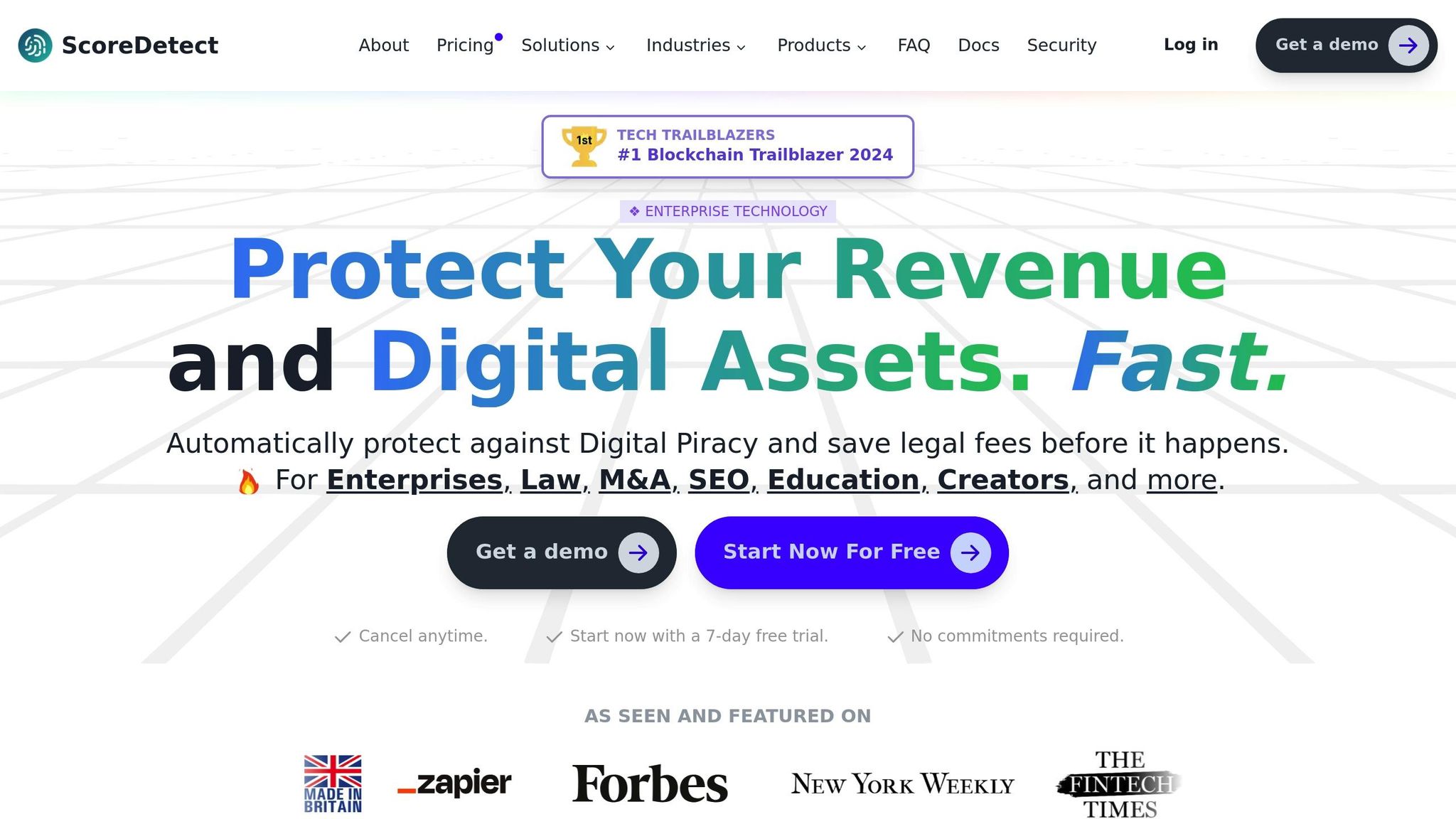Smart contracts are reshaping copyright management by automating licensing, ensuring secure transactions, and providing transparent records. These blockchain-based tools eliminate intermediaries, reduce costs, and speed up processes like royalty payments and rights verification.
Key Takeaways:
- Automation: Smart contracts manage licensing, payments, and enforcement without manual intervention.
- Transparency: Blockchain records ensure tamper-proof proof of ownership and licensing terms.
- Cost Savings: By cutting out intermediaries, creators save on fees and receive payments faster.
- Global Reach: Smart contracts simplify cross-border copyright enforcement.
- Advanced Tools: Features like perceptual hashing, automated dispute resolution, and timestamped creation records strengthen copyright protection.
Platforms like ScoreDetect integrate these technologies, offering solutions like invisible watermarks, content discovery, and automated takedown notices. While legal and regulatory gaps remain, research highlights the growing impact of smart contracts in solving copyright challenges.
How Can Smart Contracts Be Used To Manage Copyright? – CryptoBasics360.com

Research Findings: Smart Contracts for Copyright Management
Recent research and industry studies are shedding light on how smart contracts are transforming copyright management. The data shows these contracts aren’t just theoretical tools – they’re delivering noticeable improvements in real-world applications. Below, we’ll dive into the key findings, technical approaches, and examples of how smart contracts are being used effectively.
Main Findings from Recent Studies
Studies reveal that smart contracts are streamlining copyright management in several ways. For starters, automated licensing systems powered by smart contracts drastically cut down processing times. While traditional licensing agreements often take days to finalize, smart contract systems can execute transactions much faster.
Another standout benefit is the reduction in administrative costs. By removing intermediaries, smart contracts help save on fees that typically add up in traditional systems.
Accuracy in verifying rights has also improved. Traditional methods often deal with outdated databases or human errors during data entry. In contrast, smart contracts use blockchain technology, which relies on unchangeable records and automated processes, making rights verification far more reliable.
One of the most impactful findings is the ability of smart contracts to enable near-instant royalty payments. This is particularly beneficial for independent creators who often face delays in receiving their earnings.
Additionally, smart contracts are making strides in resolving copyright disputes. Instead of lengthy legal battles, many conflicts are handled automatically through pre-set contract terms, cutting down on time and effort.
Technical Methods for Smart Contract Implementation
The effectiveness of smart contracts in copyright management is supported by a range of advanced technical methods. These innovations work together to create a secure, efficient system for protecting intellectual property.
- Perceptual Hashing: This technology generates unique digital fingerprints for content, which remain consistent even if the file is slightly altered (e.g., through compression or format changes). Unlike traditional file hashes that change with any modification, perceptual hashing helps smart contracts recognize derivative works or modified versions of original content.
- Blockchain Storage: Instead of storing entire files – which would be costly – smart contracts record cryptographic hashes and metadata. This approach ensures tamper-proof ownership records while keeping storage affordable and efficient.
- Automated Dispute Resolution: Smart contracts come with built-in mechanisms to handle common copyright conflicts. These systems can automatically determine usage rights, calculate licensing fees, and even enforce penalties for unauthorized use, resolving many disputes without human intervention.
- Multi-Signature Verification: For high-value content, smart contracts often require multiple parties to approve licensing agreements or ownership transfers. This added layer of security prevents unauthorized changes while keeping the process efficient.
- Time-Stamped Proof of Creation: Smart contracts automatically record when content was created and by whom. These blockchain-based timestamps serve as legally recognized evidence in ownership disputes, offering creators a reliable way to prove their claims.
Real-World Case Studies
Practical applications of smart contracts across various industries highlight their potential to reshape copyright management.
In digital publishing, publishers report fewer licensing disputes and faster royalty payments. Automation has eliminated delays that previously frustrated authors and content creators.
The photography and visual arts sectors are seeing faster responses to copyright infringement. Smart contracts integrated with content monitoring tools can quickly identify unauthorized usage, allowing creators to take action sooner.
In the music industry, independent artists are gaining more control over their work. Smart contracts automate complex royalty calculations, removing the need for costly intermediaries and ensuring creators get paid promptly.
Even academic publishing is benefiting. Universities and research institutions are streamlining the sharing of research while maintaining proper attribution and usage controls.
These real-world examples show how smart contracts are making copyright enforcement smoother and more efficient across industries. Tools like ScoreDetect further enhance these systems by verifying ownership through content checksums, adding another layer of reliability to the process.
Legal and Regulatory Challenges of Smart Contracts
Smart contracts bring exciting possibilities for copyright enforcement, but their adoption isn’t without hurdles. The rapid pace of technological advancements has outstripped existing legal frameworks, leaving creators, businesses, and legal experts to navigate a maze of uncertainties.
Legal Recognition and Enforceability
One major question is whether smart contracts hold the same legal standing as traditional agreements. In many legal systems, there’s still no definitive framework to confirm that these automated, self-executing contracts are as enforceable as their conventional counterparts. While some jurisdictions have started to recognize blockchain records and smart contracts, most courts remain rooted in traditional principles. This creates complications for resolving disputes, especially when automated decisions – like determining copyright infringement or calculating licensing fees – are made without human involvement. Other concerns include whether blockchain evidence is admissible in court and who bears responsibility for errors in automated processes. These legal uncertainties stand in stark contrast to the efficiency and automation benefits that smart contracts promise.
Regulatory Gaps and Recommendations
Current copyright laws were not designed with smart contracts in mind, leading to notable regulatory gaps. One key issue is jurisdiction: while smart contracts operate globally, copyright laws are inherently territorial. On top of that, privacy regulations aimed at protecting personal data can clash with blockchain’s immutable nature. To address these challenges, legal experts have called for specialized regulatory frameworks that clearly define the binding nature of smart contracts, establish mechanisms for resolving disputes, and clarify jurisdictional responsibilities. Proposals like regulatory sandboxes – controlled environments for testing new technologies – could help refine these systems under flexible oversight while paving the way for standardization.
International Copyright Dispute Implications
The global nature of copyright enforcement adds another layer of complexity. When smart contracts automate enforcement across borders, it’s unclear which national laws should apply. International treaties like the Berne Convention provide some guidance, but differences in legal standards, language, and even cultural interpretations of copyright can still lead to disputes. While smart contracts can create transparent and immutable records of licensing agreements – potentially reducing disagreements – they don’t eliminate the challenges posed by varying fair use doctrines across jurisdictions. For example, rapid enforcement might unintentionally overstep in countries with broader fair use protections. Tools like ScoreDetect help by offering verifiable blockchain records of content ownership, which can support evidence in international disputes. However, resolving these disputes still depends on traditional legal processes and international collaboration.
sbb-itb-738ac1e
Current vs. Smart Contract-Based Copyright Enforcement
The move from traditional copyright enforcement to systems based on smart contracts marks a major shift in how creators safeguard their intellectual property. These two approaches differ significantly in terms of how they operate, their efficiency, and their accessibility.
Comparison Table: Current vs. Smart Contract Systems
| Aspect | Traditional Copyright Systems | Smart Contract Systems |
|---|---|---|
| Automation Level | Relies on manual processes and legal intervention | Uses automated execution and enforcement |
| Response Time | Typically involves longer response times | Allows for quick detection and prompt action |
| Cost Structure | Often incurs higher legal and administrative fees | Reduces operational costs after initial setup |
| Transparency | Provides limited visibility into enforcement actions | Offers a traceable audit trail via blockchain |
| Legal Certainty | Backed by established judicial precedents | Operates within an evolving legal framework |
| Scalability | Faces challenges in monitoring at scale | Built for high scalability and simultaneous case handling |
| Evidence Integrity | Documentation can be disputed or altered | Maintains tamper-resistant records on the blockchain |
| Global Reach | Enforcement varies by jurisdiction | Supports cross-border operations, though faces regulatory hurdles |
Research-Based Performance Insights
The comparison highlights the strengths and weaknesses of both systems, but research provides further clarity on their performance. Studies indicate that smart contract-based systems are particularly effective in managing high-volume, straightforward infringement cases. These systems excel in quickly identifying and addressing unauthorized use, making them ideal for time-sensitive scenarios. However, challenges arise when dealing with text-based content, where variations can complicate detection.
On the other hand, traditional enforcement methods still hold an edge in complex disputes that require detailed legal interpretation and contextual understanding. For cases involving nuanced issues – like determining fair use – human oversight remains essential.
Hybrid models, such as those used by platforms like ScoreDetect, demonstrate how combining automation with legal expertise can balance speed and precision. These tools streamline workflows while ensuring that the legal accuracy needed for complex cases is not compromised.
Blockchain Tools for Copyright Protection
The world of blockchain has given rise to numerous platforms tailored for copyright protection, each with its own way of merging smart contracts with digital rights management. These tools bring theoretical ideas into practical use, showing how blockchain can safeguard intellectual property. Let’s dive into how these platforms work and the unique features they offer.
Overview of Blockchain-Based Copyright Platforms
Blockchain copyright platforms generally fall into three main categories: timestamping, rights management, and anti-piracy.
- Timestamping Platforms: These tools create unchangeable records of when content was created, helping creators prove their ownership. They work by capturing cryptographic hashes of digital content and storing them on public blockchains, providing undeniable proof of existence at a specific time.
- Rights Management Platforms: Using smart contracts, these systems automate licensing and royalty payments. Creators can set terms for how their content is used, and payments are triggered automatically when conditions are met. Smart contracts also enable real-time tracking and enforcement of usage rights across different platforms.
- Anti-Piracy Platforms: These platforms combine blockchain with detection algorithms to find unauthorized use of content. They continuously scan the web, comparing discovered content to blockchain-registered originals to spot infringements. The blockchain ensures tamper-proof ownership evidence, while smart contracts can initiate takedown requests automatically when violations are found.
Research shows that platforms combining these approaches tend to be more effective, offering creators a multi-layered defense for their work.
How ScoreDetect Improves Copyright Protection

Platforms like ScoreDetect showcase how blockchain tools can protect copyrights in practical, real-world scenarios. ScoreDetect blends multiple technologies to create a robust system for safeguarding intellectual property. Instead of storing original assets, it records content checksums on the blockchain, ensuring ownership can be verified without compromising the original work.
One standout feature of ScoreDetect is its use of invisible watermarks. Unlike traditional watermarks that are visible and can be removed, these undetectable markers work alongside blockchain timestamping, adding an extra layer of protection.
ScoreDetect also excels in discovery and enforcement. With targeted web scraping, it achieves a 95% success rate in bypassing prevention measures to locate unauthorized content. Its automated takedown system is highly efficient, boasting a 96% success rate in generating and executing delisting notices. These notices are legally compliant and meet the standards of major platforms and search engines, thanks to the platform’s integration of legal expertise and automation.
The platform’s versatility is further enhanced by its integration capabilities. Through Zapier, ScoreDetect connects with over 6,000 web applications, enabling users to automate copyright protection tasks. For example, creators can set up workflows to register new content for blockchain protection as soon as it’s published on their content management systems.
Additionally, ScoreDetect offers a WordPress plugin that automatically captures and registers every article published or updated. This plugin not only creates verifiable proof of ownership on the blockchain but also boosts SEO by signaling content authenticity, delivering dual benefits for publishers and marketers.
Importance of Advanced Features
The success of blockchain-based copyright protection often hinges on advanced features that go beyond basic blockchain functionality. Automated workflows are essential for managing large volumes of content efficiently, making them a must-have for organizations with high output.
AI-powered discovery systems are another game-changer. These tools can detect not only exact copies but also modified or derivative versions of content, offering a broader range of protection than manual monitoring ever could.
Integration with content management systems is equally critical. By automating protection measures during the content creation or publishing process, these systems reduce the risk of unprotected works entering the digital space. This seamless integration ensures that copyright protection becomes a natural part of creating and sharing content, reinforcing blockchain’s role in safeguarding intellectual property in the digital age.
Future of Smart Contracts in Copyright Management
Smart contracts are poised to transform how intellectual property is protected. What began as simple automated agreements has evolved into a complex system that combines the security of blockchain with the analytical power of artificial intelligence and advanced detection tools.
The next wave of smart contract technology incorporates AI and machine learning to verify content originality, identify pirated material, and monitor copyright violations in real time. This shift allows copyright enforcement to move from being reactive to proactive, enabling smarter and faster content protection [1].
The infrastructure supporting these systems is advancing quickly. By integrating blockchain with tools like IPFS and traditional databases, these systems can securely store immutable records while handling large files, such as music fingerprints and evidentiary data, with ease [1].
Blockchain platforms have also made strides in addressing earlier challenges, such as transaction speed, latency, and security. These improvements ensure that smart contracts can handle the demands of real-world copyright management effectively [1]. For those who adopt these technologies early, the potential benefits are substantial.
A glimpse of this potential can be seen in tools like ScoreDetect, which boasts a 95% success rate in content discovery and a 96% effectiveness in issuing takedown notices. As smart contract technology continues to evolve, solutions like these demonstrate how blockchain-powered copyright protection is becoming a necessity.
Looking ahead, the future of copyright management lies in fully automated, real-time enforcement systems that simplify rights administration for creators, ensuring their work is protected seamlessly and efficiently.
FAQs
How do smart contracts streamline royalty payments in the music industry?
Smart contracts are changing the game for royalty payments in the music industry by automating the entire process. Every time a song is streamed, purchased, or licensed, these contracts rely on blockchain technology to verify the transaction and initiate immediate and precise payments to artists, producers, and rights holders.
By removing the need for manual calculations and minimizing human errors, smart contracts provide real-time transparency and cut down on delays. This technology is reshaping how artists are compensated, creating a system that’s faster and more equitable for everyone involved.
What legal challenges arise when using smart contracts for copyright enforcement across different regions?
Using smart contracts to enforce copyright comes with its own set of legal hurdles, especially when different jurisdictions are involved. A major concern is enforceability – some legal systems may not yet view smart contracts as valid, binding agreements, which complicates their use in legal disputes. On top of that, jurisdictional clashes can arise when the parties involved operate under different legal systems and regulations.
There’s also the issue of a missing global legal standard for smart contracts. Translating traditional contract laws to agreements written in code is no easy task, particularly when dealing with international transactions. This lack of clarity impacts crucial aspects like resolving disputes and ensuring compliance with various regulations, both of which are essential for safeguarding copyrights effectively.
What makes perceptual hashing different from traditional file hashing in copyright protection?
Perceptual hashing offers a unique advantage over traditional file hashing by producing similar hashes for content that appears or sounds alike, even after minor modifications like resizing or reformatting. This makes it a powerful tool for recognizing and safeguarding digital assets where such adjustments are common.
In contrast, traditional file hashing generates entirely distinct hashes for every input. Even the smallest change to a file results in a completely new hash. While this approach is excellent for ensuring data integrity, it doesn’t work as well for tasks like copyright enforcement or digital rights management. To strengthen content verification and provide more reliable copyright protection, perceptual hashing is often combined with blockchain technology.

